Biology
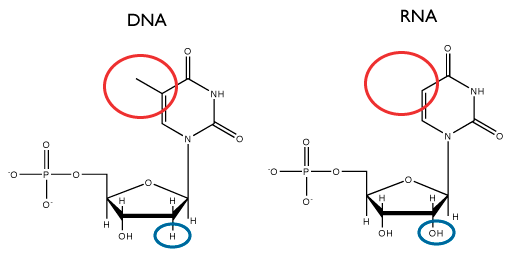 DNA molecule consists of nucleotides in which the sugar component is deoxyribose whereas the RNA molecule has nucleotides in which the sugar is a ribose.
DNA molecule consists of nucleotides in which the sugar component is deoxyribose whereas the RNA molecule has nucleotides in which the sugar is a ribose.
Nucleotides
Roles:
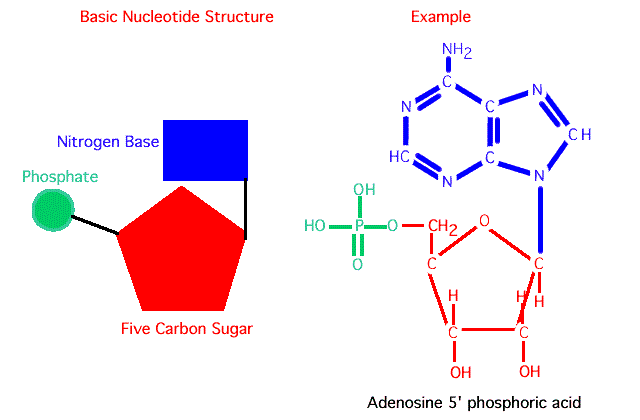
The bases are usually referred to by their first letters:
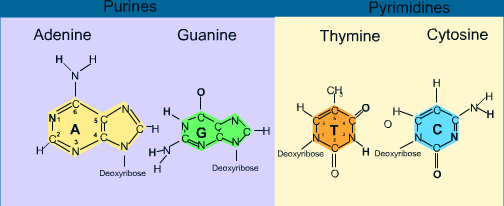
Nucleotides bond together to make nucleic acids. They form covalent bonds between the phosphate group of one and the sugar of another. This takes place through a condensation reaction.
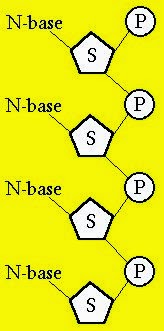
Structure of DNA and RNA
DNA and RNA are polynucleotides (long chains of nucleotides).
DNA = A, G, C, T
RNA = A, G, C, U
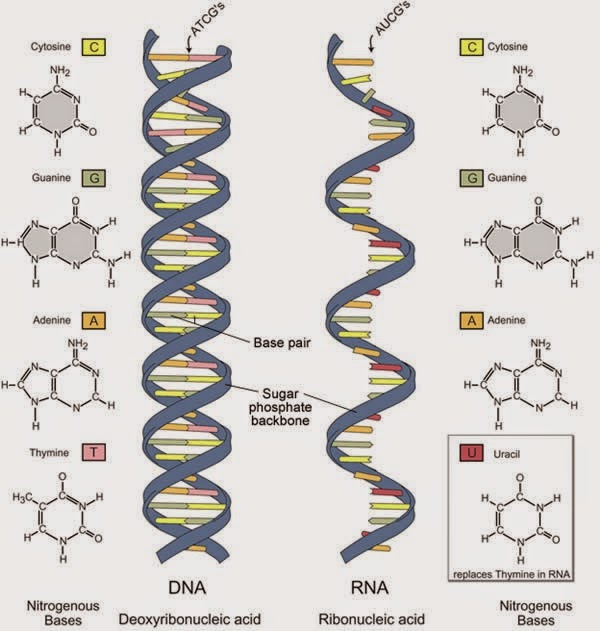
+ DNA molecule 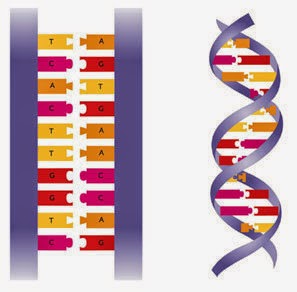
DNA Replication
New DNA molecules need to be made before a cell can divide. The 2 daughter cells must each receive a complete set of DNA. The base sequences on the new DNA molecules must be identical with those on the original set. DNA replication takes place in the nucleus, during interphase.
? Hydrogen bonds between the bases along part of the two strands are broken. This 'unzips' part of the molecule, separating the two strands.
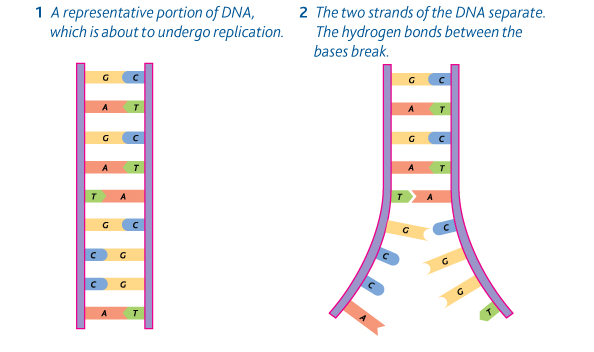
? Nucleotides that are present in solution in the nucleus are moving randomly around. By chance, a free nucleotide will bump into a newly exposed one with which it can form hydrogen bonds. Free nucleotides therefore pair up with the nucleotides on each of the DNA strands, always A with T and C with G. DNA polymerase links together the phosphate and deoxyribose groups of adjacent
nucleotides.
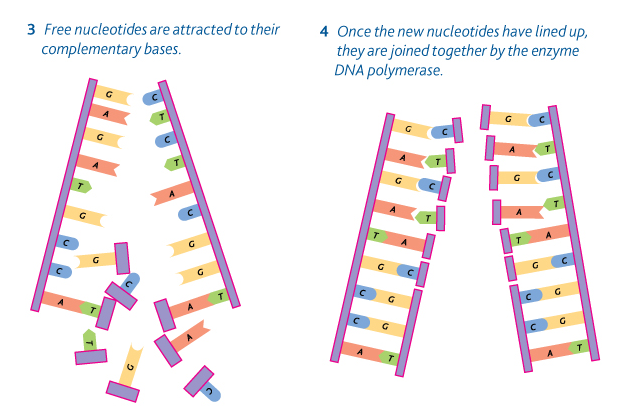
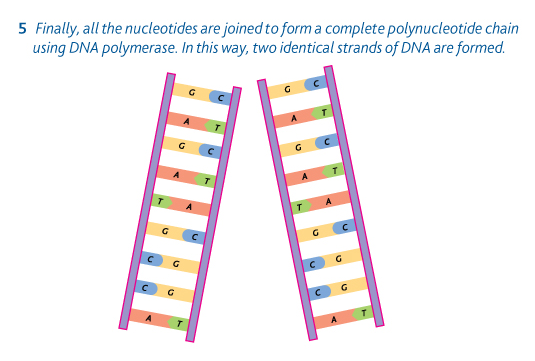
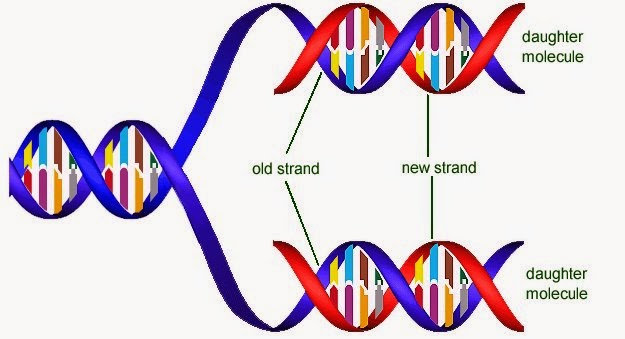
- Q: Compare And Contrast Dna Replication And Transcription
Similarities: Both processes occur in the nucleus. Both processes also involve specific complementary base pairing. Both processes involving the unwinding of the double helix DNA. Both processes involve forming of hydrogen bonds between the original DNA...
- Dna Replication
DNA Replication?DNA can copy its self over and over again in order to keep creating for the organism it is working for. This action is called DNA replication and takes place in the cell nucleus. How does DNA replication work? The molecules of DNA...
- Polynucleotide Chains Have Nitrogenous Bases Linked To A Sugar-phosphate Backbone
KEY TERMS: A nucleoside consists of a purine or pyrimidine base linked to position 1 of a pentose sugar. Positions on the ribose ring are described with a prime () to distinguish them. The difference between DNA and RNA is in the group at the 2 position...
- #37 Summary Of Genetic Control
1. DNA and RNA are polynucleotides, made up of long chains of nucleotides. 2. A nucleotide contains a pentose sugar, a phosphate group and a nitrogen-containing base. In RNA the sugar is ribose, and in DNA it is deoxyribose. 3. A DNA molecule consists...
- # 33.1 Nucleic Acids And Protein Synthesis - Syllabus 2015
? Structure and replication of DNA ? Role of DNA in protein synthesis Learning Outcomes Candidates should be able to: (a) describe the structure of RNA and DNA and explain the importance of base pairing and the different hydrogen bonding between...
Biology
# 34 DNA structurer and replication

Nucleotides
Roles:
- are monomers for nucleic acid polymers, such as DNA and RNA. The genetic material (DNA) is a polymer of 4 different nucleotides. The genetic information is coded in the sequence of nucleotides in a DNA molecule.
- adenosine triphosphate (ATP) - the nucleotide molecule that doesn't include the phosphate group - is energy carrier in metabolic pathways.
- are components of some important coenzymes: flavin adenine dinucleotide (FAD), nicotinamide adenine dinucleotide phosphate (NADP) and Coenzyme A.
- A 5-carbon sugar (deoxyribose in DNA; ribose in RNA)
- a phosphate group.
- a 1 or 2 ring nitrogen-containing base

- A = adenin,
- G =guamine,
- C = cystosine,
- T = thymine (methyl +uracil)
- U = uracil.
- A and G = purine bases (2 carbon-nitrogen rings).
- C, T and U = pyrimidine bases (1 carbon-nitrogen ring).

Nucleotides bond together to make nucleic acids. They form covalent bonds between the phosphate group of one and the sugar of another. This takes place through a condensation reaction.

Structure of DNA and RNA
DNA and RNA are polynucleotides (long chains of nucleotides).
DNA = A, G, C, T
RNA = A, G, C, U
+ RNA molecule - a single strand (may be folded up on itself).

- 2 strands run in opposite directions (anti-parallel) and twist round each other --> double helix.
- There are H bonds between the bases on the 2 strands.
- H bonding only occurs between A-T and C-G (complementary base pairing).

The significance of complementary base pairing
- Only certain pairings of bases are possible ( A-T and G-C) => 2 strands of the double helix are complementary, each the predictable counterpart of the other.
- Since the 2 strands of DNA are complimentary, they can separate from one another and each can serve as a template for building a new partner (if you know the sequence of one DNA strand then you can easily figure out the sequence of the other strand).
- Thus, DNA replication is semi-conservative, with each of the two daughter DNA molecules having one old strand derived from the parent and one newly made strand.
- The complementary base pairing results in the two daughter DNA molecules being identical.
DNA Replication
New DNA molecules need to be made before a cell can divide. The 2 daughter cells must each receive a complete set of DNA. The base sequences on the new DNA molecules must be identical with those on the original set. DNA replication takes place in the nucleus, during interphase.
Semi-conservative DNA replication
? Hydrogen bonds between the bases along part of the two strands are broken. This 'unzips' part of the molecule, separating the two strands.

? Nucleotides that are present in solution in the nucleus are moving randomly around. By chance, a free nucleotide will bump into a newly exposed one with which it can form hydrogen bonds. Free nucleotides therefore pair up with the nucleotides on each of the DNA strands, always A with T and C with G. DNA polymerase links together the phosphate and deoxyribose groups of adjacent
nucleotides.

- As each strand retains half of the original DNA material, this method of replication is called semi-consservative.


3 types of DNA replication
|
| Syllabus 2015
|
Syllabus 2016 6.1 Structure and replication of DNA Understanding the structure of nucleic acids allows an understanding of their role in the storage of genetic information and how that information is used in the synthesis of proteins. a) describe the structure of nucleotides, including the phosphorylated nucleotide ATP (structural formulae are not required) b) describe the structure of RNA and DNA and explain the importance of base pairing and the different hydrogen bonding between bases (include reference to adenine and guanine as purines and to cytosine, thymine and uracil as pyrimidines. Structural formulae for bases are not required but the recognition that purines have a double ring structure and pyrimidines have a single ring structure should be included) c) describe the semi-conservative replication of DNA during interphase |
- Q: Compare And Contrast Dna Replication And Transcription
Similarities: Both processes occur in the nucleus. Both processes also involve specific complementary base pairing. Both processes involving the unwinding of the double helix DNA. Both processes involve forming of hydrogen bonds between the original DNA...
- Dna Replication
DNA Replication?DNA can copy its self over and over again in order to keep creating for the organism it is working for. This action is called DNA replication and takes place in the cell nucleus. How does DNA replication work? The molecules of DNA...
- Polynucleotide Chains Have Nitrogenous Bases Linked To A Sugar-phosphate Backbone
KEY TERMS: A nucleoside consists of a purine or pyrimidine base linked to position 1 of a pentose sugar. Positions on the ribose ring are described with a prime () to distinguish them. The difference between DNA and RNA is in the group at the 2 position...
- #37 Summary Of Genetic Control
1. DNA and RNA are polynucleotides, made up of long chains of nucleotides. 2. A nucleotide contains a pentose sugar, a phosphate group and a nitrogen-containing base. In RNA the sugar is ribose, and in DNA it is deoxyribose. 3. A DNA molecule consists...
- # 33.1 Nucleic Acids And Protein Synthesis - Syllabus 2015
? Structure and replication of DNA ? Role of DNA in protein synthesis Learning Outcomes Candidates should be able to: (a) describe the structure of RNA and DNA and explain the importance of base pairing and the different hydrogen bonding between...
